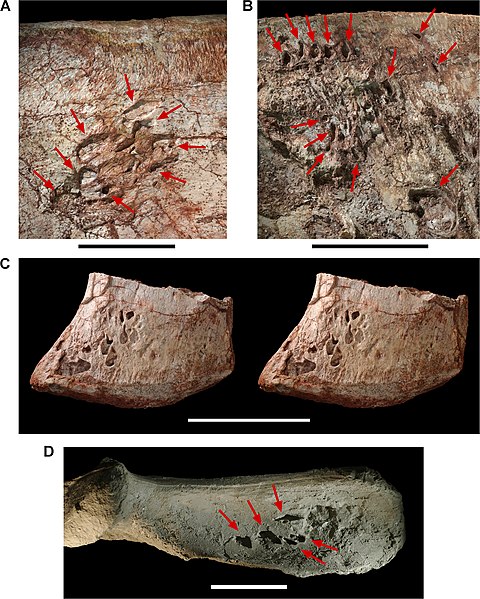[Recent Entries][Archive][Friends][User Info]
Below are the 1 most recent journal entries recorded in the "Сообщество, посвящённое ра" journal:| February 18th, 2015 | |
|---|---|
| 04:39 pm [industrialterro] [Link] |
Aerosteon Аэростеон (Aerosteon, от др.-греч. ἀερο- + ὀστέον «воздушная кость») — род ящеротазовых динозавров из семейства Neovenatoridae, подотряда тероподов, живший в меловом периоде около 85 — 74 миллионов лет назад, на территории нынешней Южной Америки. Окаменелости теропода были найдены в Аргентине. Описаны Полом Серено в 2008 году. Всего известен один скелет Aerosteon. Представлен единственным видом — A. riocoloradensis. В результате анализа дыхательной системы этого ящера было найдено сходство с современными птицами. Этот анализ окаменелостей показывает эволюционные связи между динозаврами и современными птицами. Aerosteon is a genus of either allosauroid or tyrannosauroid theropod dinosaur from the Late Cretaceous period of Argentina. Its remains were discovered in 1996 in the Anacleto Formation, dating to the Santonian stage (about 84 million years ago). The type and only known species is A. riocoloradense. Its specific name indicates that its remains were found 1 km north of the Río Colorado, in the province of Mendoza. They show evidence of a bird-like respiratory system. Aerosteon's name can be translated as air bone and derives from Greek ἀήρ (aer, "air") and ὀστέον (osteon, "bone"). Though the species name was originally published as "riocoloradensis", Greek ὀστέον is neuter gender, so according to the ICZN the species name must be riocoloradense to match. Aerosteon was a 9 metre (30 ft) long, 2 metric ton bipedal carnivorous dinosaur that lived approximately 83 million years ago during the Santonian stage. The remains discovered include a single tooth, some cranial bones, a number of partial or complete vertebrae from the neck, back, and sacrum, several cervical and dorsal ribs, gastralia, furcula (wishbone), left scapulocoracoid, left ilium, and left and right pubes. The incomplete fusion of some of its bones indicate that it was not quite fully mature. Aerosteon did not initially appear to belong to any of the three groups of large theropods that were known to have inhabited the southern continents during this time (namely the Abelisauridae, Carcharodontosauridae or Spinosauridae). Sereno suggested that it might be related to the allosauroid radiation of the Jurassic period, and this was confirmed in subsequent studies that recognized a clade of late-surviving, lightly built, advanced allosauroids with large hand claws similar to the spinosaurs, called the Megaraptora, within the allosaur family Neovenatoridae. A later analysis has placed Aerosteon within the Tyrannosauroidea. Some of Aerosteon's bones show pneumatisation (air-filled spaces), including pneumatic hollowing of the furcula and ilium, and pneumatisation of several gastralia, suggesting that it may have had a respiratory air-sac system similar to that of modern birds. These air sacs would have acted like bellows, moving air into and out of the animal's relatively inflexible lungs, instead of the lungs being expanded and contracted as occurs with mammals. See avian respiratory system for more detailed information on this. Sereno theorises that this respiratory system may have developed to assist with regulating body temperature and was later co-opted for breathing. Aerosteon was first described by Sereno et al. in a paper which appeared in the online journal PLoS ONE in September 2008. However, at the time, the International Code of Zoological Nomenclature did not recognize online publication of names for new species as valid unless print copies were also produced and distributed to several libraries, and that this action is noted in the paper itself. PLoS ONE initially failed to meet this requirement for Aerosteon. On 21 May 2009, the journal's managing editor coordinated with the ICZN to correct this oversight, publishing a comment to the original paper with an addendum stating that the requirements had been met as of that date. Consequently, though the description appeared in 2008, Aerosteon was not a valid name until 2009. Неовенаториды (Neovenatoridae) — семейство больших плотоядных динозавров, из надотряда Allosauroidea, живших в меловом периоде около 130—70 миллионов лет назад. Неовенаториды являются последними представителями аллозавроидов, по крайней мере один из их представителей — Orkoraptor жил в конце мелового периода (маастрихт), примерно 70 миллионов лет назад. Лопатки более короткие и широкие, маленькие, длинные передние конечности с большими когтями, приспособленные к быстрому бегу ноги и тазовые кости, которые для пневматизации имели заполненные воздухом полости и были легче по сравнению с другими Allosauroidea. Взрослые особи достигали размера от 175 кг (фукуираптор) до примерно 2500 кг (хилантаизавр). В 2009 году кладистический анализ проведенный Роджером Бенсоном и его коллегами, показал, что группа Carcharodontosauridae требует пересмотра, и необходимо было разделить ее на две ветви. Одна ветвь включала более традиционные виды, которые считались Carcharodontosauridae и сохранила свое название, другая ветвь состояла из Neovenator и некоторых родственных видов и была названа в 2010 году Neovenatoridae. Семейство Neovenatoridae было определено как: группа, состоящая из всех видов более тесно связаных с Neovenator salerii, чем Carcharodontosaurus saharicus, Allosaurus fragilis и Sinraptor dongi. ( Read More ) Размеры тела в сравнении с человеком: Tags: Вымершие рептилии, Мел, авеметатарзалии, архозавроморфы, архозавры, диапсиды, динозавроморфы, динозавры, карнозавры, неовенаториды, тероподы, ящеротазовые |






